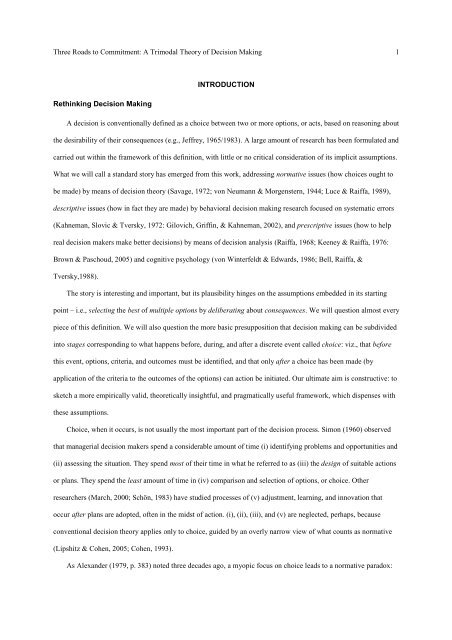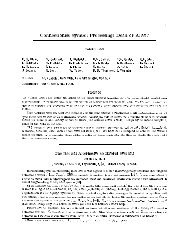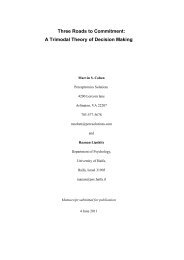Three Roads to Commitment: A Trimodal Theory of Decision Making
Three Roads to Commitment: A Trimodal Theory of Decision Making
Three Roads to Commitment: A Trimodal Theory of Decision Making
Create successful ePaper yourself
Turn your PDF publications into a flip-book with our unique Google optimized e-Paper software.
<strong>Three</strong> <strong>Roads</strong> <strong>to</strong> <strong>Commitment</strong>: A <strong>Trimodal</strong> <strong>Theory</strong> <strong>of</strong> <strong>Decision</strong> <strong>Making</strong> 1<br />
INTRODUCTION<br />
Rethinking <strong>Decision</strong> <strong>Making</strong><br />
A decision is conventionally defined as a choice between two or more options, or acts, based on reasoning about<br />
the desirability <strong>of</strong> their consequences (e.g., Jeffrey, 1965/1983). A large amount <strong>of</strong> research has been formulated and<br />
carried out within the framework <strong>of</strong> this definition, with little or no critical consideration <strong>of</strong> its implicit assumptions.<br />
What we will call a standard s<strong>to</strong>ry has emerged from this work, addressing normative issues (how choices ought <strong>to</strong><br />
be made) by means <strong>of</strong> decision theory (Savage, 1972; von Neumann & Morgenstern, 1944; Luce & Raiffa, 1989),<br />
descriptive issues (how in fact they are made) by behavioral decision making research focused on systematic errors<br />
(Kahneman, Slovic & Tversky, 1972: Gilovich, Griffin, & Kahneman, 2002), and prescriptive issues (how <strong>to</strong> help<br />
real decision makers make better decisions) by means <strong>of</strong> decision analysis (Raiffa, 1968; Keeney & Raiffa, 1976:<br />
Brown & Paschoud, 2005) and cognitive psychology (von Winterfeldt & Edwards, 1986; Bell, Raiffa, &<br />
Tversky,1988).<br />
The s<strong>to</strong>ry is interesting and important, but its plausibility hinges on the assumptions embedded in its starting<br />
point – i.e., selecting the best <strong>of</strong> multiple options by deliberating about consequences. We will question almost every<br />
piece <strong>of</strong> this definition. We will also question the more basic presupposition that decision making can be subdivided<br />
in<strong>to</strong> stages corresponding <strong>to</strong> what happens before, during, and after a discrete event called choice: viz., that before<br />
this event, options, criteria, and outcomes must be identified, and that only after a choice has been made (by<br />
application <strong>of</strong> the criteria <strong>to</strong> the outcomes <strong>of</strong> the options) can action be initiated. Our ultimate aim is constructive: <strong>to</strong><br />
sketch a more empirically valid, theoretically insightful, and pragmatically useful framework, which dispenses with<br />
these assumptions.<br />
Choice, when it occurs, is not usually the most important part <strong>of</strong> the decision process. Simon (1960) observed<br />
that managerial decision makers spend a considerable amount <strong>of</strong> time (i) identifying problems and opportunities and<br />
(ii) assessing the situation. They spend most <strong>of</strong> their time in what he referred <strong>to</strong> as (iii) the design <strong>of</strong> suitable actions<br />
or plans. They spend the least amount <strong>of</strong> time in (iv) comparison and selection <strong>of</strong> options, or choice. Other<br />
researchers (March, 2000; Schön, 1983) have studied processes <strong>of</strong> (v) adjustment, learning, and innovation that<br />
occur after plans are adopted, <strong>of</strong>ten in the midst <strong>of</strong> action. (i), (ii), (iii), and (v) are neglected, perhaps, because<br />
conventional decision theory applies only <strong>to</strong> choice, guided by an overly narrow view <strong>of</strong> what counts as normative<br />
(Lipshitz & Cohen, 2005; Cohen, 1993).<br />
As Alexander (1979, p. 383) noted three decades ago, a myopic focus on choice leads <strong>to</strong> a normative paradox:




